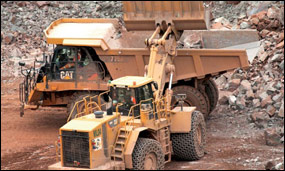
Specialised Fluids
Today?s earthmovers are big beasts. Typical mining equipment can generate 650 HP and boast a lifting capacity of 90,000 pounds (41 tonne). During the last 25 years or so, the performance and sophistication of off-highway machinery has increased dramatically. There have been increases in power, power density and torque with each successive model. This increase in power density generates more heat, raising oil sump temperatures throughout the drivetrain. Transmissions, differentials and final drives are subjected to increasingly higher loads as machines become capable of shifting larger quantities of material and much faster. The surface finish of components, their design and metallurgy have steadily improved but they still require the highest level of lubrication to deliver maximum performance and remain durable..
A key development in the field of off-highway equipment has been the powershift transmission. They are complex, with a wide range of ratios and contain a variety of hardware technology including epicyclic gear sets, wet clutches and brakes, and in the case of infinitely variable transmissions (IVT), a combination of epicyclic gears and hydrostatic drives. They may also incorporate hydraulic actuators which are sensitive to the viscosity and the type of lubricant used. .
Earlier, powershift transmissions had to make do with engine oil for function and lubrication as specialised fluids didn?t exist. For convenience, engine oils were used throughout the drivetrain but their performance in that role was severely limited and there were many shortcomings. In powershift transmissions, they provided poor friction, marginal anti-wear, problems with oxidation and oil seals and also poor sludge control. Maintenance costs were unnecessarily high in those days and equipment failure high. Today, things have changed considerably. Powershift transmissions in modern equipment would not meet the required performance levels if engine oils or general fluids were used in place of specialised fluids. Specialised fluids minimise repairs and maintenance, and maximise performance and equipment life..
Key Features of Specialised Fluids
Frictional stability ensures operating efficiency when moving heavy loads on inclines, supporting metallic and non-metallic materials properly by delivering appropriate frictional properties. This includes the needs of clutches and wet disc brakes, resulting in longer clutch life and elimination of wet brake noise. .
Anti-wear properties protect planetary and helical gears as well as heavily loaded final drive gears against macro-pitting and fatigue.
Compatibility with elastomers used in rings and seals avoids leaks and doesn?t corrode copper alloys.
Low-temperature fluidity inhibits wear in cold weather starting and allows easier cold weather operation.
Oxidation stability ensures the fluid won?t degrade at high temperatures resulting in longer fluid life, particularly in extreme operating conditions.
Sludge control prevents lubricant passages from being blocked, resulting in longer equipment life.
Rust and corrosion protection extends equipment life and promotes trouble-free operation.
Foam protection prevents fluid loss due to foaming, reducing wear from metal-to-metal contact and protecting the operator from the fire and safety hazards associated with fluid overflow.
Thermal stability provides consistent performance under a variety of temperatures.
Hydraulic pump performance protects high-pressure hydraulic systems.
Lubrication of clutches, wet brakes, vane pumps, planetary gear sets, final drive gears and bearings (metal-to-metal).
Sustained film thickness promotes protection of highly loaded gears and long-term anti-wear protection.
Shear stability maintains the viscosity grade over the life of the lubri?cant and provides wear protection, resulting in no loss of applied pressure that could result in slippage and equipment failure.
The development of specialised fluids has brought huge benefits in terms of increased performance and increased hardware protection and productivity. Today, it is more important than ever to use the right fluid in these applications to avoid costly repair bills along with the associated downtime and loss of productivity.


 +91-22-24193000
+91-22-24193000 Subscriber@ASAPPinfoGlobal.com
Subscriber@ASAPPinfoGlobal.com